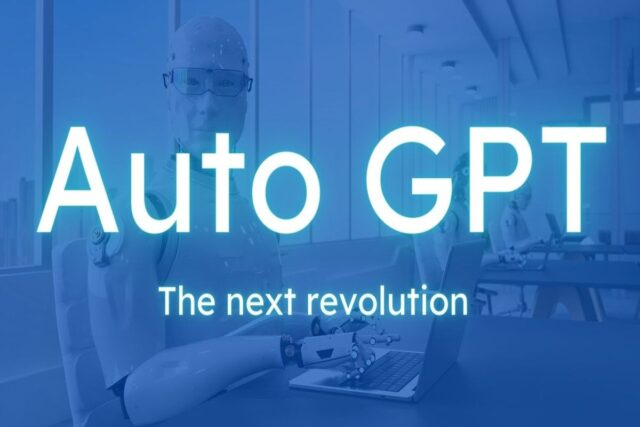The arrival of the groundbreaking artificial intelligence (AI) tool, AutoGPT, is generating lots of enthusiasm in the AI world. Here, we will dive into what AutoGPT is, how it operates, its capabilities and shortcomings, and see how it relates and competes with other AI models such as ChatGPT.
Artificial intelligence revolutionizes our world, enabling machines to learn, reason, and adapt. From predictive analytics to virtual assistants, AI’s impact spans industries, promising innovation and efficiency. However, ethical considerations and responsible deployment are crucial to harnessing AI’s transformative potential without compromising societal values.
AutoGPT is among the latest AI tools which uses the latest language models of OpenAI to execute many tasks autonomously. There are several examples of AutoGPT already in action and they can be utilized for complex process automation.
What Is AutoGPT?
AutoGPT is an open-source tool that utilizes the latest generative language models from OpenAI, particularly GPT-3.5 and GPT-4, to generate advanced text distinctively and uniquely from popular AI models.
For instance, unlike ChatGPT, which offers responses according to particular prompts or instructions offered by humans, AutoGPT can work fully autonomously without any human supervision.
The main difference between AutoGPT compared to other similar tools is its ability to autonomously plan the steps needed to achieve a goal by self-generating prompts and iteratively processing the available results.
From a technical point of view, we can say that AutoGPT utilizes unsupervised learning methods to understand language patterns and generate coherent text that is customized to execute particular tasks, avoiding the dreaded ‘hallucinations’ in AI (machine errors that result in misinterpretations of signals or data).
Moreover, AutoGPT comes with internet search capabilities, short and long-term memory management, and integration with external applications and OpenAI APIs, making it an extensive all-in-one AI tool.
While AutoGPT was originally launched as an open-source project on GitHub, more user-friendly interfaces such as AgentGPT and GodMode have come to make it easier for non-experts to use.
Related: AI Tech Demand Exploded By 500% In 12 Months Boosted By ChatGPT Success
AutoGPT Launch
The origin of AutoGPT dates back to late 2022. Originally, it was developed by Toran Bruce Richards, a software engineer and video game developer, who released the source code of the tool on GitHub under an open-source license.
Nevertheless, it was not until mid-January 2023 that it started attracting viral attention on social media, thanks to its many benefits, attracting enthusiasts and renowned figures within the artificial intelligence industry.
Within a few weeks, AutoGPT accumulated tens of thousands of stars on GitHub, exceeding even the popular PyTorch repository dedicated to deep learning. As of November 1, 2023, AutoGPT had more than 152,000 stars on GitHub, representing its huge potential for intelligent automation.
AutoGPT In Practice
To use AutoGPT, you first have to install it locally and set up an API account with OpenAI to access the language models. Then, in a command-line interface, you define a prompt, let’s take “Help me boost my fast-food business” as one example.
After the prompt gets submitted, AutoGPT generates a plan to assist you with the request, such as doing market research on fast food (it’s worth noting that the more detailed your prompt, the better and more detailed its response will be). AutoGPT then executes every step, collecting information from the internet, creating text files for note-taking, and offering you a response based on its research.
In case it encounters obstacles or has restricted information, AutoGPT will automatically try to develop new prompts to enable itself to progress successfully. That way, even the users who are less experienced at creating prompts can get the most accurate answers to all their questions.
AutoGPT Use Cases
One of the highly promising uses of AutoGPT is in content automation and creative tasks. For example, it can autonomously generate ideas, drafts, summaries, scripts, and product descriptions, saving valuable time for journalists, writers, and content creators.
Another exciting area where AutoGPT can outshine a human is in repetitive administrative tasks such as managing schedules, emails, and documents. AutoGPT can take care of drafting simple texts, data organization, and other complex activities.
AutoGPT can also excel in customer service, offering automatic responses 24/7 to tedious inquiries from dissatisfied users. Furthermore, in case you are a programmer, AutoGPT can help streamline your work since it has been trained to debug, write, and document software code automatically.
Taking into context all these examples, we can conclude that AutoGPT represents massive potential for tasks that need analysis or processing of large volumes of data, whether in science, finance, or legal research, enabling human users to focus on more creative projects or tasks.
Related:What Is AI Art?
AutoGPT vs. ChatGPT
While both tools utilize OpenAI’s language models, there are considerable differences in their operation and capabilities. For example, ChatGPT was particularly trained to generate conversational text, whereas AutoGPT has a widespread focus and is entirely free.
Another notable difference between the powerful AI tools is that ChatGPT relies fully on user-provided prompts, while AutoGPT can come up with its prompts and autonomously execute multi-step plans to achieve a particular goal.
One more relevant difference is that AutoGPT can link and interact with external applications and web services to collect information and take action, while OpenAI’s popular tool, ChatGPT, is limited to text generation.
Ultimately, AutoGPT has highly advanced capabilities, including learning through trial and error, enabling it to optimize responses over time. On the other hand, ChatGPT has limited learning capabilities, making it less flexible.
The Takeaway
AutoGPT represents a notable advancement in the autonomy of AI networks. Its ability to optimize results, plan tasks, and interact with the digital world makes it a versatile and powerful tool.
Nonetheless, there are also possible risks that have to be minimized to guarantee that the new technology keeps evolving positively, streamlining tasks without replacing the distinct skills of human creativity and ingenuity.









